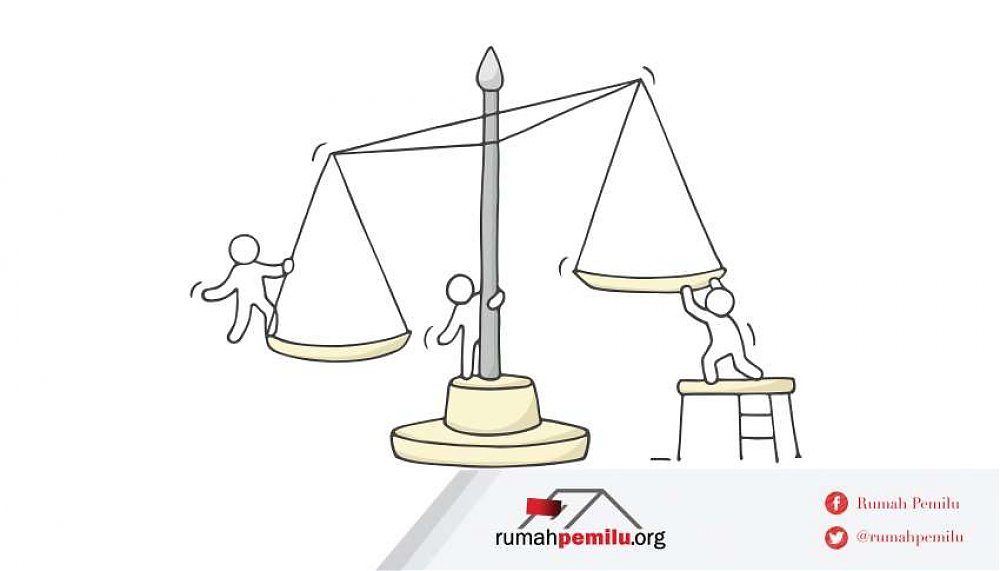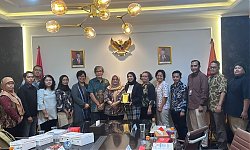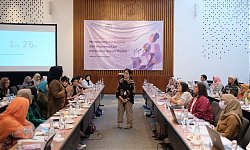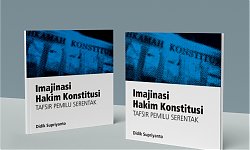Tuesday (29/3), Association for Election and Democracy or Perludem with the support from The Asia-Pacific Regional Support for Elections and Political Transitions (RESPECT) program, hold a discussion on the topic “APJED Goes to Public, Transitional Justice in Southeast Asia: Theory and Practice”. This discussion aims to give appreciation to the author of the Asia-Pacific Journal of Elections and Democracy (APJED), a journal managed by Perludem and Djokosoetono Research Center.
“This forum is to share the author’s ideas, broaden the audience, increase traffic, and citation,” said Chief of Party RESPECT, Theresia Joice Damayanti.
Aulia Nastiti, Ph.D candidate in Political Science, Northwestern University is a source person in the discussion. She wrote a paper “Transitional Justice in Southeast Asia: Theory and Practice.
Two dominant theories of transitional justice
To explain transitional justice, Aulia used two theories, namely the balance of power theory by Sam Huntington, and the justice cascade developed mostly by Kathryn Sikkink.
A variety of transitional justice measures depends on the mode of transition. Huntington identifies three types of transition. The first is transformation, where a decision to reform comes from the old regime who had contra opposition, and they want to keep their power by changing the political climate.
“So, the institution might change, but the dominant power is still the same,” said Aulia.
Second, transplacement. The old elite declines power but negotiates exit terms to avoid judicial measures to make them accountable. Third, replacement. Old regimes or elites lost power and are completely ousted. The new regime is very strong.
Those three varieties lead to the varied outcome of the justice process. In the transformation type, the justice process leads to impunity. In transplacement, there will be negotiated justice. And in replacement, lead to trial and impunity.
Meanwhile, in the justice cascade theory, in Catherine’s observation, starting from the 90s, among many countries democratizing, there is an increase in attempts to hold a human rights trial and prosecution for the post-authoritarian regime. This phenomenon is called a justice cascade. By definition, justice cascade theory is a global increase of accountability norms against human rights offenders, even with diverse democratization manners. The justice cascade is mainly driven by the international norms diffusion of human rights protection, by the human rights activists, public interest lawyers, jurists as “norm entrepreneurs” who over the decades mounted legal challenges to push through changes.
“So, she actually tried to oppose Huntington’s theory by saying that it is not really depend on the mode of transition, because we see the increase of accountability attempts, even in countries with diverse democratization transition mode. This theory really emphasizes the importance of demand-side factors, the role of civil society to explain the emergence of human rights prosecutions. This is explained justice from below, rather than Huntington’s story of the struggle between the political allies,” Aulia explained.
Empirical realities in Southeast Asia
Southeast Asia, according to Aulia, is adopting transitional justice in a relatively delayed manner rather than Latin America or Eastern European. There are four countries she analyzed, namely Cambodia, Philippines, Indonesia, and East Timor. These countries adopted some measures of justice, but not all of them adopt the measures equally.
In these countries, Aulia identifies the three most common measures of transitional justice, namely truth commission, offender prosecution or the trial, and some attempts of victim preparation.
“In my cases that I look at, the three measures actually appear in Cambodia, but they dare equally appear in the three other cases,” Aulia concluded.
Cambodia
The transitional justice in Cambodia has been adopted in particular to address the masculine and crimes committed by the Khmer Rouge regime from 1975 to 1979. The primary justice measure in Cambodia is the establishment of the Extraordinary Chambers in the Courts of Cambodia (ECCC).
“It’s a hybrid core because the jurisdiction applied in this court is both international and national law. Partially international court and partially national court to hold accountable those who were most responsible for the crimes and serious violation of Cambodian penal law, and international humanitarian law recognized by Cambodia,” she told.
The transitional justice in Cambodia is a relatively successful process because it’s not only could punish the high-rank people in the Khmer Rouge regime, but it also made attempts to victim support the production of legal culture rooted in international law, and gave people a means to begin to recognize, and transition from the base of Khmer rouge through the establishment of a truth commission.
From the theoretical assessment, the outcome of transitional justice in Cambodia cannot be viewed based on the balance of power theory, because the theory cannot explain the delayed timing of the justice process. In Cambodia, the transitional justice process starts very late, and the new rulers of the Cambodian state were not incentivized to punish Khmer Rouges even after their replacement.
“So, the mode is a replacement. Huntington hypothesizes that a replacement means that the outcome is punishment. It is true, but the incentive is actually better explained by the justice cascade theory. It is actually come from international pressure, international norms of human rights protection. However, the justice cascade theory gets the primary actor a little wrong, because the role of civil society here is quite minimum, compared to the international institution, and the demand only came after the ECCC has been established by the international institution,” she revealed.
East Timor
The transitional justice in East Timor has happened in the context of postcolonial states against former colonizers. The attempt to conduct transitional justice came immediately after the Referendum 1999. The UN Transitional Administration established a serious crime unit and make special tribunals that are mandated to investigate and prosecute cases of war crimes against humanity which was committed by the occupiers.
But the transitional justice was not really successful to put them on trial. Mostly, the process emphasized a reconciliatory and reparative victim, preparation approach rather than the judiciary mechanism. Furthermore, the reconciliation and reparative measures are established through the CAVR and CTF, the committee that is co-established by Indonesian and East Timor. And even, the member of the East Timor political elite has used the transitional justice discourse selectively to support their own agenda.
“Due to the awareness of geopolitical constraint in facing Indonesia, East Timor’s leaders have promoted an agenda of reconciliation as forgiveness and forgetting. That’s why East Timor’s government decide to pursue justice more at the associated level by establishing a truth commission and victim reparation rather than trying to hunt down the high-rank human rights abusers who are mostly Indonesian,” Aulia explicate.
From the theoretical assessment, point of view of the balance of power theory, justice is the result between the exiting rulers and the incoming political elites, but the outcome is not as hypothesized by Huntington. Replacement, but the justice measures are more negotiated.
On justice cascade theory, this theory is more helpful in terms of making sense of how the justice process is largely driven by international norms of human rights, but not enough to explain why demand force does not yield a more comprehensive justice, as the Cambodian case.
Philippines
Transitional justice in the Philippines in regard to Marcos’s human rights abuses stalled, as Marcos went unpunished despite his exile. The post-Marcos government tried to have attempted to make transitional justice measures by creating the commission of human rights, however, the power of this commission is very limited to making recommendations and not deciding on the prosecution. The decision is in the government.
“Studies said that transitional justice post-Marcos is superficial and performative. Because despite the establishment of those committees’ it doesn’t reach a conclusive answer. It doesn’t give society closure, nor give victims any reparative measures,” she clarifies.
From theoretical assessment, Huntington characterized the Philippines as a replacement transition, but the outcome contrast with Huntington’s theoretical expectation. The output should be comprehensive and drive to the punishment of the outgoing authoritarian regime.
Transitional justice cascade theory also has a limited explanatory power to make sense of the Philippines case. The demand is very strong, the civil society activism is quite vibrant, but it still doesn’t translate into the adoption of meaningful justice measures.
Indonesia
Indonesia has various cases of human rights abuse: 1965 mass killing, 1984 Tanjung Priok, 1991 East Timor, 1998 Reformation, and 2003 Aceh. In all these cases, the outcomes are varied, but largely fail to provide justice measures. In some cases, justice is negotiated, like in Aceh and East Timor. Mostly, justice is defined in alternative and localized conception that is to advantage the political elites or human rights abusers themselves. Even, the reconciliatory and restorative measures are very limited.
“It is seen most disappointingly from the way Indonesian government deal with the 1965 anti-communist violence which until today, there have been grassroots activism and international pressure, at the national level the state has still treated communism as a latent threat. So, it is not even trying to provide the truth commission or common historical ground to the society, let alone the victim preparation and trial for the offenders,” as described by Aulia.
Same as the Philippines, the case of Indonesia doesn’t really fit the theoretical expectation. The transition is fit with transplacement mode, but the justice outcome is largely impunity for the past dictator. According to the balance of power theory, is limited in making sense of various and selective justice outcomes under the same process of transition.
From the justice cascade point of view, the strong demand and human rights norms do not translate into a meaningful justice process.
Alternative pathways
From the empirical cases, one common insight is that elites’ political decisions seem to be the key mechanism or proximate cause in getting transitional justice. This seemed obvious in almost all cases.
“The remaining question is then to us, under what condition the political elites would have incentives to pursue justice process,” she questioned.
As a reflection on the cases and the two existing dominant theories, Aulia proposed a potential alternative explanation. The first one is, that the actual outcomes of justice may depend on whether elites can circumvent international norms and turn to localized notions of what counts as justice to serve their political interests. The second is, it depends on whether elites can frame the violence as legitimate to what extent the legitimacy of violence is institutionalized in the collective memory. The third is, it depends on how much the current ruling regime is actually complicit in perpetrating violence, and to what extent do they have political power and influence are compromised if they decide to pursue transitional justice. []
AMALIA SALABI











